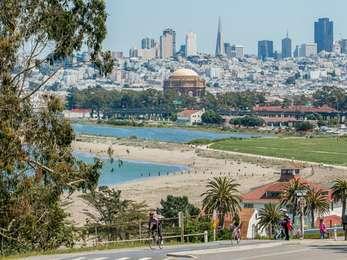Last updated: March 3, 2021
Place
4 - A Place of Renewal

WAYSIDE DESCRIPTION: At the edge of the East Beach parking lot, is a kiosk, a four-sided metal structure with three wayside panels. Facing west from the kiosk, the San Francisco Bay Trail is to your right, hugging the edge of the bay, and stretches on into the distance towards Crissy Field and to the north west, the Golden Gate Bridge. To the left, and south, is a concrete bathroom building in a grassy field. The bathroom also includes a dog wash station and water fountain. To the east, is the Crissy Field Center.
PANEL #1: A Place of Renewal
TEXT: The land known today as Crissy Field has undergone many changes. once a rich salt marsh and homeland of Ohlone people, it was later a landing site for Spanish and Russian explorers, a venue for the Panama-Pacific International Exposition and a pioneering United States military airfield.
Along with the entire Presidio, Crissy Field was designated a National Historic Landmark in 1962. With generous community support, Crissy Field has been transformed into a spectacular 100-acre shoreline park at the center of the Golden Gate National Recreation Area.
Revitalizing Crissy Field. Sponsored by the National Park Service and its nonprofit support partner, the Golden Gate National Parks Conservancy, the revitalization of Crissy Field owes its success to community support and stewardship. The Evelyn and Walter Haas, Jr. Fund provided the lead gift for site restoration, and many other individuals and organizations from throughout the Bay Area generously contributed time and funding.
As part of the site restoration effort in 1998-2000, individuals and groups from schools, corporations and civic organizations planted more than 100,000 native plants to help restore natural habitat at Crissy Field. Community volunteers continue to play an important role in sustaining long-term stewardship of this national parkland.
ILLUSTRATIONS: In the lower portion of this panel are three illustrations of plants.
ILLUSTRATION #1: An illustration of pink sand verbena, a plant that also grows on a vine, with a vertical structure to its blossom. The blossom is pink and round like a sphere, the petals growing in more of a three-dimensional pattern. The green triangle-shaped leaves with rounded edges grow above and below the flower.
ILLUSTRATION #2: An illustration of Indian paintbrush, a plant with teardrop-shaped leaves alternating their way up its stalk to a red blossom.
ILLUSTRATION #3: An illustration shows a vertical plant with five small, round blue blossoms at the top of its stalk: silver bush lupine. Lower down on the stalk are five crinkly looking leaves, and at the very bottom, a dense section of smaller leaves growing close together.
CAPTION: Silky hairs on the silver bush lupine's leaves reflect heat and protect them from drying out. Capable of fixing nitrogen from the air, an advantage in nutrient-poor sand, these plants can live many decades.
PANEL #2: Enjoying Crissy Field
TEXT: The National Park Service invites you to enjoy all that Crissy Field, the Presidio and the Golden Gate National Recreation Area have to offer. Crissy Field has been designed to accommodate a variety of uses. For the safety and enjoyment of all visitors and the protection of national park resources, please obey park rules.
DESCRIPTION OF MAP: A map of the San Francisco Bay coastline, from the San Francisco side, that includes Marina Gate and Entry Grove to the east and stretches all the way to the Golden Gate Bridge to the west. Several areas within the parkland are labeled, including the Warming Hut to the west near Fort Point, then moving east: Golden Gate Promenade, the Tidal Marsh and East Beach.
TEXT: Regulations. Please:
- Obey all posted regulations.
- Adhere to special regulations for the wildlife protection area.
- Note that bicycles are subject to all motor vehicle laws.
The following are prohibited:
- Glass bottles and containers.
- Fires on beach.
- Organized sports
- Camping
- Collecting plants and other natural objects
- Removing historic artifacts
- Feeding or disturbing wildlife
- Parking in unpaved areas except as designated
PANEL #3: Fog & Wind at the Gate
TEXT: The San Francisco Bay Area is noted for its microclimates. The Maritime climate at Crissy Field is one of moderate temperatures-averaging between 50 and 60 degrees Fahrenheit year-round-with a total precipitation of 20 inches annually. However, the wind that funnels continually through the Golden Gate creates harsh conditions here. The salty ocean wind dries and blows the sand ashore, fashioning dunes, blasting and covering plants and perpetually remodeling the shoreline landscape.
During summer the wind causes colder deep seawater to surface. The cold water condenses the moist air to form fog. As heated air inland rises, the fog is drawn eastward through the Golden Gate and over the coastal ridges, making San Francisco summers typically cool.
DESCRIPTION OF IMAGE: A photograph of a windsurfer, leaning at a 45-degree angle with arms outstretched, holding on to the white sail of his board.
CAPTION: The wind at Crissy Field can be not only invigorating to walkers and runners, but it also offers boardsailors one of the most challenging sites in the world. The best boardsailing conditions occur between March and October, when the wind blows strongly onshore.
TEXT: How Crissy Field Got Its Name. In 1918, the U.S. Army sent 61 airplanes racing in short hops across the continental United States to test aircraft reliability and endurance. Major Dana H. Crissy led the west-to-east contingent, which left from the still-unmanned airfield at the Presidio. He died in a crash on the first day out. In 1921, Major Hap Arnold, pioneer military aviator and later a five-star general, saw to it that the air base was named in Crissy's honor.
DIRECTIONS TO NEXT WAYSIDE: In the bottom left corner of the panel is a black and white photograph of Major Crissy, standing in profile with his arms behind his back, wearing full aviator uniform with hat and goggles resting on top of his head.
